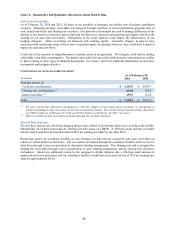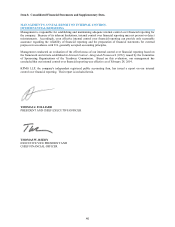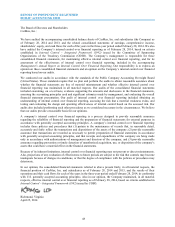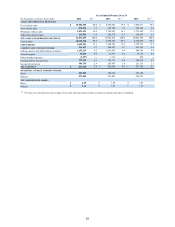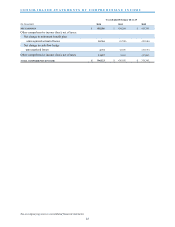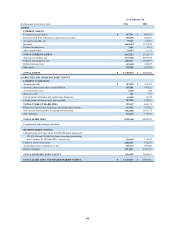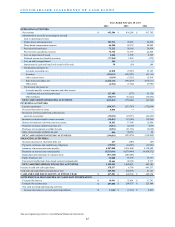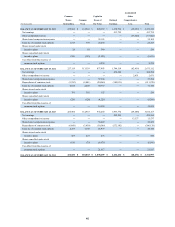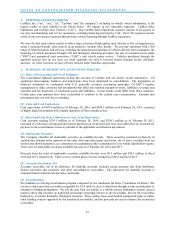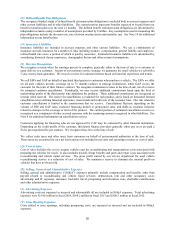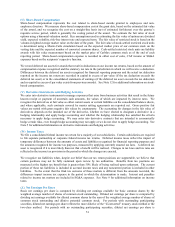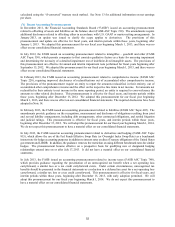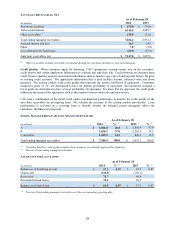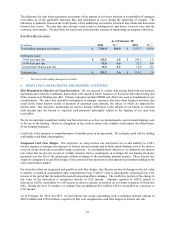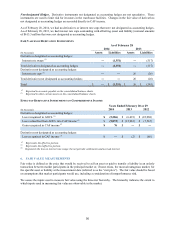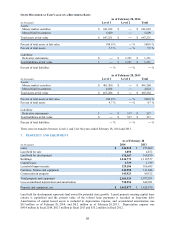CarMax 2014 Annual Report Download - page 53
Download and view the complete annual report
Please find page 53 of the 2014 CarMax annual report below. You can navigate through the pages in the report by either clicking on the pages listed below, or by using the keyword search tool below to find specific information within the annual report.
49
Interest income and expenses related to auto loans are included in CAF income. Interest income on auto loan
receivables is recognized when earned based on contractual loan terms. All loans continue to accrue interest until
repayment or charge-off. Direct costs associated with loan originations are not considered material, and thus, are
expensed as incurred. See Note 3 for additional information on CAF income.
(J) Property and Equipment
Property and equipment is stated at cost less accumulated depreciation and amortization. Depreciation and
amortization are calculated using the straight-line method over the shorter of the asset’s estimated useful life or the
lease term, if applicable. Property held under capital lease is stated at the lesser of the present value of the future
minimum lease payments at the inception of the lease or fair value. Amortization of capital lease assets is computed
on a straight-line basis over the shorter of the initial lease term or the estimated useful life of the asset and is
included in depreciation expense. Costs incurred during new store construction are capitalized as construction-in-
progress and reclassified to the appropriate fixed asset categories when the store is completed.
ESTIMATED USEFUL LIVES
Life
Buildings 25 years
Capital lease 20 years
Leasehold improvements 15 years
Furniture, fixtures and equipment 3 – 15 years
We review long-lived assets for impairment when events or changes in circumstances indicate the carrying amount
of an asset may not be recoverable. We recognize impairment when the sum of undiscounted estimated future cash
flows expected to result from the use of the asset is less than the carrying value of the asset. We recognized an
impairment of $0.1 million in fiscal 2014 and $0.2 million in fiscal 2012 related to assets within land held for sale.
There was no impairment of long-lived assets in fiscal 2013. See Note 7 for additional information on property and
equipment.
(K) Other Assets
Goodwill and Intangible Assets. Goodwill and other intangibles had a carrying value of $10.1 million as of
February 28, 2014 and February 28, 2013. We review goodwill and intangible assets for impairment annually or
when circumstances indicate the carrying amount may not be recoverable. No impairment of goodwill or intangible
assets resulted from our annual impairment tests in fiscal 2014, fiscal 2013 or fiscal 2012.
Restricted Cash on Deposit in Reserve Accounts. The restricted cash on deposit in reserve accounts is for the
benefit of holders of non-recourse notes payable, and these funds are not expected to be available to the company or
its creditors. In the event that the cash generated by the securitized receivables in a given period was insufficient to
pay the interest, principal and other required payments, the balances on deposit in the reserve accounts would be
used to pay those amounts. Restricted cash on deposit in reserve accounts was $32.5 million as of February 28,
2014, and $41.3 million as of February 28, 2013.
Restricted Investments. Restricted investments includes money market securities primarily held to satisfy certain
insurance program requirements, as well as mutual funds held in a rabbi trust established to fund informally our
executive deferred compensation plan. Restricted investments totaled $40.2 million as of February 28, 2014, and
$35.0 million as of February 28, 2013.
(L) Finance Lease Obligations
We generally account for sale-leaseback transactions as financings. Accordingly, we record certain of the assets
subject to these transactions on our consolidated balance sheets in property and equipment and the related sales
proceeds as finance lease obligations. Depreciation is recognized on the assets over 25 years. Payments on the
leases are recognized as interest expense and a reduction of the obligations. See Notes 11 and 15 for additional
information on finance lease obligations.
(M) Other Accrued Expenses
As of February 28, 2014 and February 28, 2013, accrued expenses and other current liabilities included accrued
compensation and benefits of $120.7 million and $103.4 million, respectively; loss reserves for general liability and
workers’ compensation insurance of $29.7 million and $26.6 million, respectively; and the current portion of
cancellation reserves. See Note 8 for additional information on cancellation reserves.


